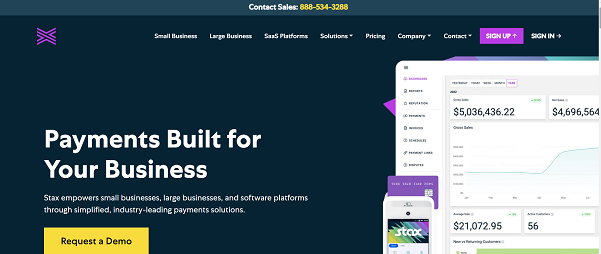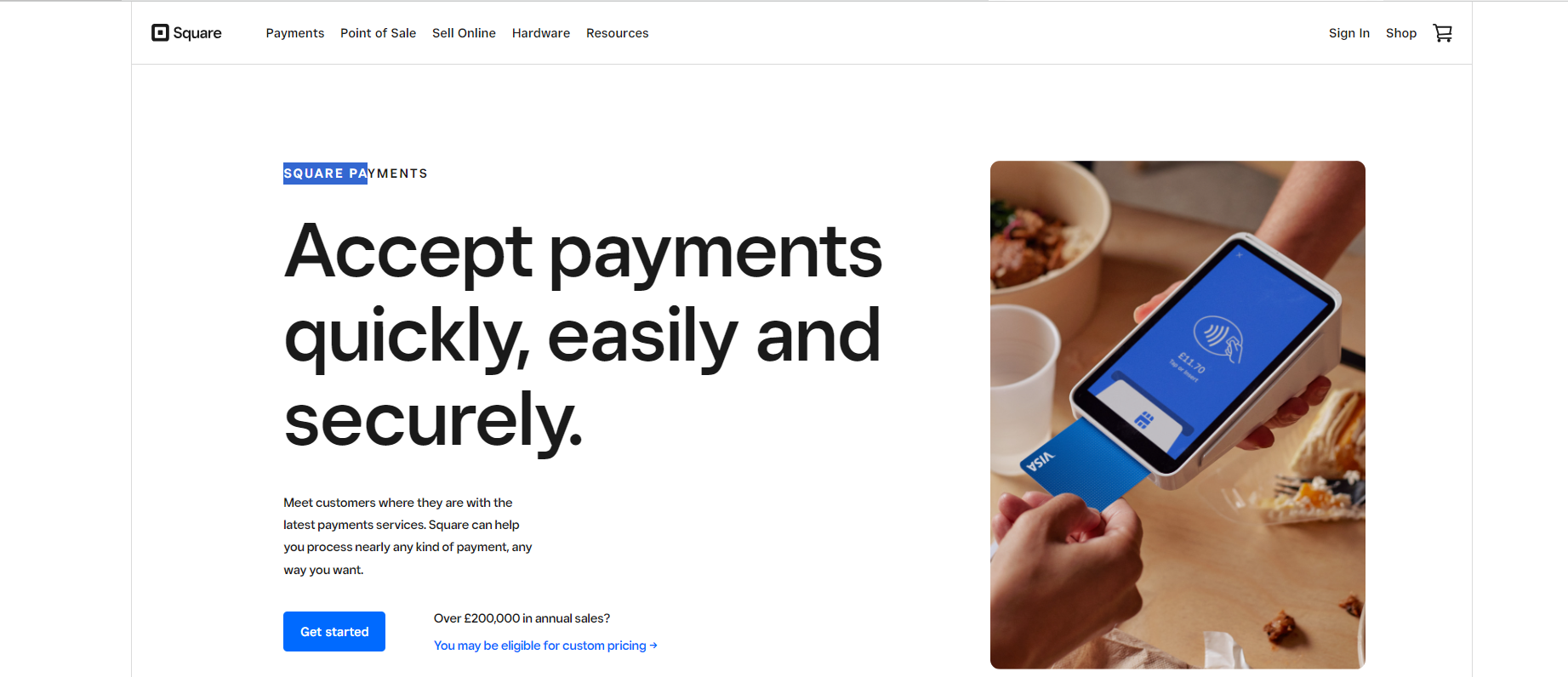
Finding a suitable credit card processor for your restaurant can be a challenge. With so many options on the market, making the right choice needs careful research and consideration.
That’s where this blog comes in handy, offering an in-depth view of top payment processors that restaurants should consider. Now, let’s dive into finding your perfect match!
Stripe: Ideal for Seamless Online Orders and Delivery Services
- Online transactions: 2.9% + $0.30
- In-person transactions: 2.7% +$0.50
- Keyed-in transactions: 3.4% +$0.30
Payment Depot: Best for Small, Well-Established Restaurants
- In-person transactions: interchange + $0.80
- Card-not-present: Interchange + $0.18
Stax: Unbeatable Value for Midsize and Full-Service Restaurants – Best for Affordability
- In-person transactions: interchange + $0.8
- Card-not-present: Interchange + $0.18
Square Payments: Best for Effortless Setup in Small and Startup Restaurants
- Online transactions: 2.9% + $0.30
- In-person transactions: 2.6% +$0.10
- Keyed-in transactions: 3.5% +$0.15
Helcim: Best for Seamless Invoicing
- In-person transactions: 0.3% +$0.8
- Card-not-present transactions: 0.5% + $0.25
Top Credit Card Processing Services for Restaurants

For restaurants centering their business model on online food orders and deliveries, Stripe excels with its tailored solutions for such operations.
Thanks to its competitive rates, payment Depot takes the cake for well-established smaller restaurants. Midsize and full-service establishments find excellent value in Stax’s offerings that blend affordability with comprehensive features.
The most accessible setup crown goes to Square Payments, perfect for small or newly opened restaurants needing straightforward systems.
Lastly, Helcim shines in sectors like catering services, where invoicing is common. With an emphasis on fraud prevention and flexible payment plans, it provides a robust solution for this niche segment of the restaurant industry.
All these processors bring unique advantages to different aspects of restaurant operations, providing owners with much-needed options for managing transactions effectively while keeping costs within check.
Stripe: Best for Online Orders and Delivery Services
Stripe is a top credit card processing service for restaurants, particularly suited for online orders and delivery services.
Overview & Benefits of Stripe
Stripe is the top credit card processor for restaurants focusing on online food ordering, delivery services, and ghost kitchens. One of the significant advantages of Stripe is that it offers a free merchant account, allowing restaurants to accept customer payments easily.
Additionally, Stripe is highly integratable with popular restaurant POS systems, making it convenient for restaurant owners to manage their transactions seamlessly. Moreover, Stripe provides 24/7 support to assist restaurants with any issues or inquiries.
For added security, Stripe’s machine learning system called Radar helps detect false accounts and prevent fraudulent activities. Overall, Stripe offers a reliable and efficient payment processing solution for restaurants looking to enhance online operations while keeping transaction costs in check.
Stripe Pricing & Card Reader
Stripe offers competitive restaurant pricing options, making it an attractive choice for many businesses. Here are the critical aspects of Stripe’s pricing and its card reader:
- Competitive Pricing: Stripe offers restaurant owners a transparent and competitive pricing structure. They charge a flat rate per transaction with no hidden fees or additional costs.
- No Monthly Fees: One of the advantages of using Stripe is that there are no monthly fees or subscription charges. This allows restaurants to save money and only pay for the transactions they process.
- Customized Card Reader: Stripe provides a versatile card reader that can be customized to fit your restaurant’s needs. Whether you need a countertop terminal or a mobile card reader, Stripe has you covered.
- Easy Integration: With Stripe, integrating their payment processing system into your existing ePOS system or website is seamless. They offer APIs with excellent documentation and 24/7 support, making it easy to set up and maintain.
- Fraud Prevention: Stripe takes fraud prevention seriously. Their advanced machine learning algorithms, including the “Stripe Radar” feature, help detect false accounts and prevent fraudulent transactions.
- Free Merchant Account: One standout feature of Stripe is that they offer a free merchant account, saving restaurants from additional costs associated with setting up an account.
Pros & Cons of Stripe
Stripe offers many benefits for restaurants, particularly those focused on online orders and delivery services. Yet, like any solution, it has a few drawbacks. Let’s explore these in depth.
Pros
- Stripe is ideal for online orders and delivery services, helping streamline the payment process for these business models.
- Stripe offers 24/7 support, ensuring restaurant owners can get assistance whenever needed.
- With easy integration with over 1,000 programs, Stripe makes it easy to sync your payment processing with other parts of your business.
- Stripe’s APIs have excellent documentation, further simplifying the process of integration.
- Stripe Radar uses machine learning to prevent fraud, providing extra security for your transactions.
- It accepts all types of mobile wallets, providing flexibility for your customers.
Cons
- Based on pay-as-you-go, its pricing model is expensive for smaller restaurants with high transaction volumes.
- For businesses that do not have a solid online presence, there might be better choices than Stripe.
- The interface may be daunting for non-tech-savvy users, making it easier to use with technical assistance.
- Not all features may be necessary for smaller businesses, leading to unused services at a cost.
- Stripe’s customer service can sometimes be slow, which can cause delays in resolving issues.
- There needs to be multi-currency support for restaurants that deal with international customers.
Payment Depot: Ideal for Small, Well-Established Restaurants
Payment Depot is the perfect choice for small, well-established restaurants looking for competitive rates and payment flexibility. Find out why it’s a top pick in the blog!
Overview & Benefits of Payment Depot
Payment Depot is an ideal credit card processing service for small, well-established restaurants. With custom pricing based on individual needs and transaction volumes, Payment Depot ensures that restaurants only pay for what they need.
Unlike traditional processors, Payment Depot operates on a membership-based model, offering transparent pricing without hidden fees or markups. Starting at just £39 monthly, their low-cost membership fee can significantly reduce restaurant processing costs and boost profitability.
Plus, with 24/7 customer support available, restaurant owners can have peace of mind knowing that help is always just a phone call away.
Payment Depot Pricing & Card Readers
Payment Depot offers cost-effective pricing options for small, established restaurants. Here are the key details:
- Cheapest fees in the industry
- No contract required
- Extensive POS integrations available
- No markup on transaction fees
- Equipment reprogramming provided
Pros & Cons of Payment Depot
Payment Depot is famous among small, well-established restaurants due to its transparent pricing and unique features. However, like any other service, it has its advantages and disadvantages.
Pros
- Offers a flat-rate pricing model, beneficial for businesses with small margins.
- Known for transparency in pricing with no hidden fees, it provides businesses with predictability in their expenses.
- Provides access to a virtual terminal for secure credit card processing, allowing transactions to be processed swiftly and securely.
- Advanced security measures, including PCI compliance and encryption methods, provide safety and peace of mind.
- Offers next-day funding, which can significantly assist with cash flow for smaller restaurants.
- Provides various payment options and equipment choices, catering to varying needs and preferences.
- Offers 24/7 customer support, ensuring help is available whenever needed.
Cons
- The flat-rate pricing model might only be cost-effective for some restaurants, particularly those with high-volume sales.
- While the pricing is transparent, it might still be high for some slight or newly established restaurants.
- Some restaurants might find the virtual terminal interface less user-friendly and intuitive than other platforms.
- Despite the high level of security, some restaurants prefer more traditional payment processing methods.
- While next-day funding is convenient, some restaurants prefer instant transaction approvals for better cash flow management.
- The range of equipment choices could be overwhelming for some, particularly those new to credit card processing.
- While customer support is always available, the quality and response time of support can vary.
Stax: Best Value for Midsize and Full-Service Restaurants

With its competitive rates and comprehensive payment tools, Stax offers the best value for midsize and full-service restaurants.
Overview & Benefits of Stax
Stax is a leading credit card processing solution that offers exceptional value for midsize and full-service restaurants. With Stax, you can enjoy the convenience of hardware-free credit card processing, eliminating the need for costly equipment.
This means you can save money while providing your customers with a seamless payment experience.
One of the standout features of Stax is its support for stored payments and recurring billing. This makes it an ideal choice for restaurants offering meal kit programs or subscription-based services.
You can easily set up automatic payments and ensure a hassle-free customer experience.
When it comes to pricing, Stax offers a unique subscription model. Instead of charging transaction fees, they provide wholesale interchange-plus rates on every transaction. This allows you to have more predictable costs and potentially save money in the long run.
Stax Pricing & Hardware
Stax offers affordable pricing and hardware options for midsize and full-service restaurants. Here are the details:
- Monthly subscription fee in exchange for wholesale interchange-plus rates on transactions.
- No hidden fees or long-term contracts.
- Transparent and competitive pricing structure.
- Flexible payment plans to suit your restaurant’s needs.
- Integration with popular gateways for seamless payment processing.
- Hardware – free credit card processing, eliminating the need for expensive equipment.
- Efficient customer support to help you with any technical issues or inquiries.
Pros & Cons of Stax
Stax can be an optimal solution for your restaurant’s credit card processing needs, offering a comprehensive suite of features. However, like any platform, it also has its drawbacks. Here’s a quick rundown of the pros and cons of using Stax.
Pros
- Stax is value-for-money, offering affordable rates for midsize and full-service restaurants.
- Stax supports hardware-free credit card processing, reducing the need for additional equipment.
- Stax offers advanced security features like end-to-end encryption, ensuring your transactions are always protected.
- Stax provides a robust dashboard for easy business management.
- Stax supports stored payments and recurring billing, making it suitable for meal kit programs.
Cons
- Some users may find the subscription pricing model less attractive than other processors’ pay-as-you-go models.
- The hardware-free model may only be ideal for some businesses, particularly those that need portable card readers.
- Extra diligence may be required to ensure compliance with Stax’s security practices to maintain these high levels of protection.
- The dashboard may seem complex to some users, especially those unfamiliar with payment processing platforms.
- Depending on the business model, certain restrictions on accumulated charges and recurring billing may exist.
Square Payments: Easiest Setup for Small and Startup Restaurants

Square Payments offers the most straightforward setup for small and startup restaurants, providing a seamless payment solution that is quick to implement.
Overview & Benefits of Square Payments
Square Payments is ideal for small and startup restaurants due to its easy setup process. With Square, you can quickly accept credit card payments without hassle.
One of the standout benefits of Square Payments is its free built-in POS system and online ordering site specifically designed for restaurants. This means you can easily manage your orders, track inventory, and streamline your operations all in one place.
Another advantage of using Square Payments is that they do not charge surcharge fees for different types of cards. Whether your customers are paying with Visa, Mastercard, or American Express, you won’t have to worry about extra costs eating into your profits.
Additionally, Square has waived chargeback fees, which helps protect your business from fraudulent transactions.
Square offers these great features at no additional cost to you as a restaurant owner and doesn’t require an approval process like many other payment processors do.
This means you can get started immediately without waiting for account approval.
Square Payments Pricing & Card Readers
Square Payments offers transparent and affordable pricing options for small and startup restaurants. Here are the details:
- Flat-Rate Processing: Square charges a flat-rate fee of 2.6% + £0.10 per transaction for all major credit cards.
- No Monthly Fees: Square does not impose monthly fees, unlike other processors, making it a budget-friendly option.
- Free Card Readers: Square provides free card readers that can be used with smartphones or tablets, allowing you to accept payments from anywhere.
- Additional Hardware Options: For restaurants that prefer more advanced hardware, Square offers a range of options, including square terminal and contactless payment readers.
Pros & Cons of Square Payments
Square Payments has several benefits and drawbacks that should be considered by restaurants looking for a credit card processing service. Here’s a breakdown of the pros and cons in a tabular format:
Pros
- Easy setup process that is beneficial for small and startup restaurants.
- Square Payments offers a complete system that includes hardware and software.
- It provides a comprehensive ecosystem of tools and features, including inventory management, gift cards, and customer feedback.
- There are no monthly fees, which can help control costs for small businesses.
- It’s very flexible and can work well with various business models.
Cons
- While the setup is easy, the fees can add up for larger transactions.
- It is less robust than other processors and may not be suitable for larger restaurants.
- Costs can increase quickly with additional services and features.
- Transaction fees can be high compared to other processors.
- Customer support could be improved.
Helcim: Best for Catering Services that Invoice

Helcim is the ideal credit card processing service for catering services that frequently invoice customers. Find out why Helcim stands out in the restaurant industry and how it can benefit your business! Read more to explore all the features and advantages of using Helcim as your payment processor.
Overview & Benefits of Helcim
Helcim is widely recognized as the best credit card processor for catering services in the restaurant industry. One of their standout features is that they don’t charge monthly account fees, making it an affordable option for businesses of all sizes.
What sets Helcim apart is its invoicing service, which supports various payment methods, such as one-time, recurring, and partial payments. This flexibility is precious for catering services requiring down payments or multiple installments.
Additionally, Helcim offers ACH and over-the-phone payment options for added convenience. However, it’s worth noting that Helcim does charge extra fees for American Express transactions and has limited back-office integrations.
Also, remember that their mobile credit card reader is on the pricier side compared to other available options.
Aside from these benefits, Helcim also provides a stand-alone smart terminal with built-in point-of-sale (POS) features like inventory management and customer tracking tools. Including a receipt printer streamlines operations further by consolidating functions into one device.
Helcim Pricing & Card Readers
Helcim offers competitive pricing for its credit card processing services. Here are the details:
- No monthly account fees
- Invoicing, recurring billing, website builder, and virtual terminal are included at no extra cost.
- Supports various payment methods, including one-time, recurring, and partial payments, as well as ACH and over-the-phone payments
- Additional fees for Amex transactions
- Limited back-office integrations
- Mobile credit card reader is one of the more expensive options in the industry.
Pros & Cons of Helcim
Helcim is significantly valuable for catering services that extensively use invoices. However, like all services, there are both pros and cons associated with using it. Let’s delve into them below:
Pros
- Helcim provides a comprehensive solution with competitive pricing and no hidden fees, ensuring transaction transparency.
- The company offers invoicing capabilities, a feature handy for catering operations within the restaurant industry.
- It has robust security measures that can help reduce fraudulent charges and chargebacks, ensuring a safer transaction environment.
Cons
- Reviewing monthly statements can be challenging and time-consuming, with a need to understand various processing charges.
- While the company offers competitive pricing, it’s crucial to negotiate rates with Helcim for lower overall costs.
- Increased security measures occasionally require additional investment and regular updates for proper functioning and maintaining a secure environment.
Other Notable Credit Card Processing Services for Restaurants
Several other credit card processing services are worth considering for restaurants. One option is Revolut Business, which offers competitive rates and a range of payment methods to accommodate different customer preferences.
Shopify POS is another notable choice, with its integrated POS system and seamless online payment capabilities. Elavon is a popular option for international businesses, offering features such as multi-currency support and fast funding speeds.
Additionally, Clover provides industry-specific solutions for restaurants, including robust POS systems and advanced fraud detection tools. These providers offer unique benefits that cater to the specific needs of restaurant owners seeking reliable and efficient credit card processing services.
Why Restaurants Need Credit Card Processing Services
The convenience and efficiency of credit card processing services are crucial for restaurants. Customers, nowadays, prefer cashless transactions for their ease and speed. The use of credit cards in dining establishments is increasing as diners choose to go plastic — not just for luxury or high-end establishments but even at small cafés or food trucks.
Moreover, such a system helps improve service delivery and significantly boosts customer satisfaction. These services aid in streamlining operations by reducing wait times with quick transaction processing.
They also provide detailed transaction records that can be especially beneficial when tracking sales or doing analytics. Credit card processing makes handling financial transactions easier while allowing restaurant owners to focus more on enhancing food quality and customer service.
Choosing the Right Credit Card Processor for Your Restaurant
When selecting a credit card processor for your restaurant, consider your business model and the payment tools that are available to you. Also, consider the monthly and transaction fees associated with each processor.
Business model
Different payment processors operate on various business models, with impacts seen in the pricing patterns and service structures they offer.
For businesses operating online primarily, considering options like Stripe is wise due to their competence in managing online food orders and delivery systems. Payment Depot may be the more affordable option due to its comparatively lower fees when looking at smaller establishments that have been trading for some years already.
Larger or full-service restaurants might find value-for-money solutions with Stax. If invoicing plays a significant role in your operations, such as catering services or banquet halls – Helcim may be the ideal fit.
Available payment tools
Advanced payment tools make it easier to handle transactions in restaurants. They include card readers, mobile app payments, and online services designed for secure processing.
For instance, Stripe supports online food ordering, while Helcim caters to invoicing needs for catering services and banquet halls. Whether settling a bill at the table or serving customers from your ghost kitchen, these features can streamline operations significantly.
Payment Depot offers an economical choice with its low fees for small establishments. These diverse tools enhance the payment flexibility of any restaurant business model – crucial in today’s digital age, where customers demand quick and effortless checkout experiences.
Monthly and transaction fees
Credit card processors impose different types of fees. Monthly and transaction fees are two standard charges restaurant owners must take into account when selecting a service. The monthly fee, often termed a subscription or flat rate, is an ongoing charge for using the payment processing platform.
This could vary based on the number of terminals used, features availed, or tier level opted by the restaurant owner.
On the other hand, transaction fees apply every time a credit card payment is processed. These costs may be determined by factors such as the type of payment (in-store vs online), the card brand involved (Visa vs American Express), or your business size and sales volume.
For instance, Payment Depot provides low-cost fees for small but established restaurants.
There’s no one-size-fits-all solution here; each restaurant must carefully assess its average sales volumes and projected growth against these recurring expenses to choose an affordable yet effective credit card processor.
Keeping a handle on these cost components is essential because they can significantly influence your bottom-line profits over time.
Frequently Asked Questions about Restaurant Payment Processors
What is a restaurant payment processor?
A restaurant payment processor is a service that enables restaurants to accept credit and debit card payments from their customers. It acts as the intermediary between the restaurant and the customer’s bank, securely transmitting payment information for authorization and settlement.
The processor ensures that transactions are processed smoothly, quickly, and securely, allowing restaurants to manage their cash flow efficiently. By using a payment processor, restaurants can offer convenient payment options to their customers while minimizing the risks of handling cash transactions.
Do restaurants need a specific payment processor?
Restaurants do need a specific payment processor that caters to their unique needs. With various payment options and tools, restaurants must choose a processor to handle their business model.
Factors such as transaction fees, card reader costs, and funding speed also come into play when selecting a suitable processor.
From online orders and delivery services to small, well-established establishments or midsize full-service restaurants, there are specific processors like Stripe or Stax that cater best to their needs.
What is the sound processing rate for restaurants?
A reasonable restaurant processing rate typically falls between 1.5% and 3.5% of each transaction. Negotiating rates with your processor can lower costs, especially if you have a tiered plan.
It’s essential to consider American Express processing rates when choosing a payment processor for your restaurant, as they usually process payments at higher rates than Mastercard or Visa.
Compatibility with existing POS systems is also crucial when selecting a payment processor, so consider this factor.
How do I get the lowest processing rates for my restaurant?
To secure the lowest processing rates for your restaurant, opting for a payment processor that offers a predictable flat-rate pricing structure without any monthly fees is advisable.
By choosing a processor with this pricing model, you can ensure transparency and avoid unexpected charges. Additionally, consider working with a reputable processor specializing in serving the restaurant industry, as they may offer competitive rates tailored to your specific needs.
Conclusion
In conclusion, choosing the right credit card processing service for your restaurant is crucial to ensuring smooth and efficient transactions.
Whether you’re a small startup or a well-established eatery, finding a suitable credit card processor can help streamline your operations and provide a seamless payment experience for your customers.
So, take the time to research and select a processor that aligns with your specific needs and business goals.
Best POS software









